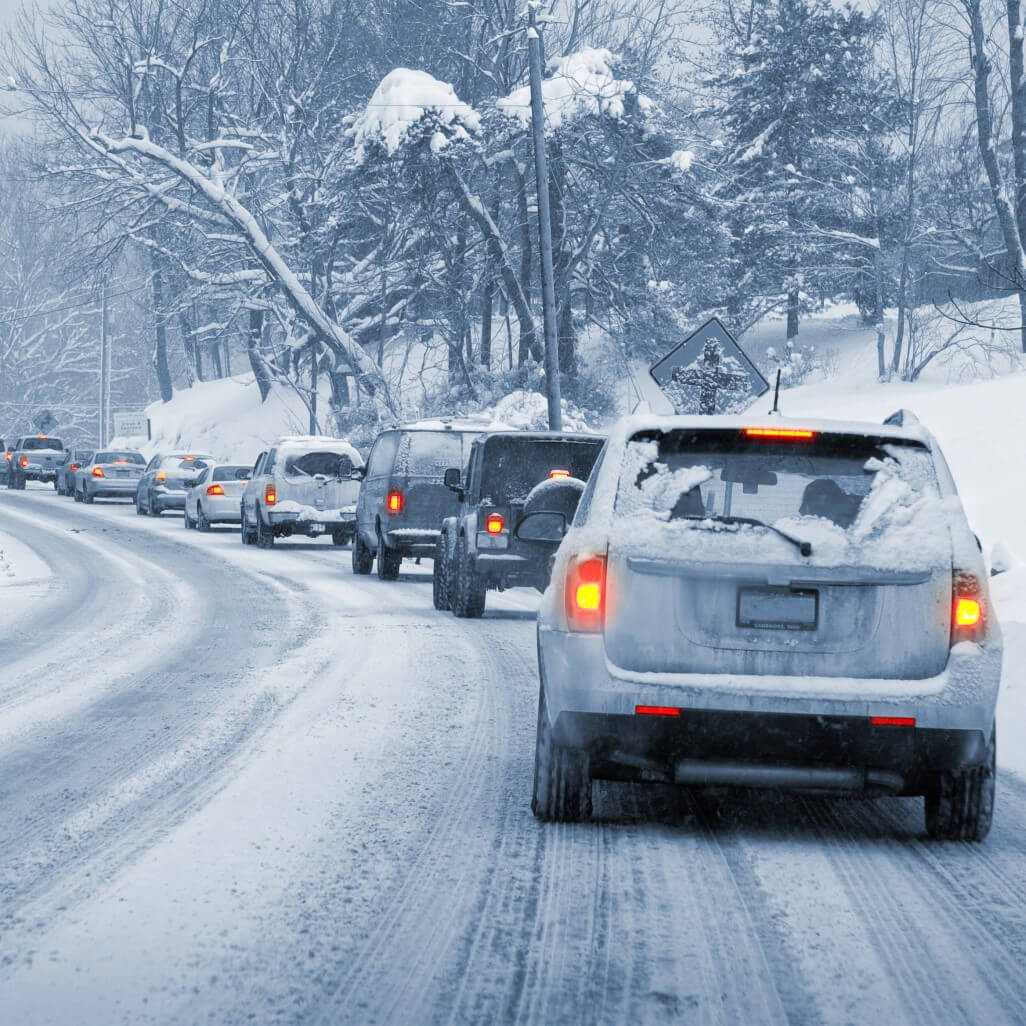Winter in Pennsylvania is fairly harsh, with temperatures ranging from about 19°F to 33°F and an average of 38 inches of snow a year. Depending on where in Pennsylvania you live and work, you could find yourself driving in snow, rain, and sleet throughout the winter. It’s important to understand what hazards are present so you know what to expect and how to avoid an accident.
The top winter driving hazards in Pennsylvania are:
Black Ice
Black ice is one of the most dangerous road conditions because it’s practically invisible. Although it’s called black ice, it is actually a transparent glaze of ice on roads, sidewalks, driveways, and other surfaces. Black ice forms when there is a light freezing rain or when snow, ice, or rain melts and re-freezes, most often at night or in the early morning.
Black ice is more likely to be found on roads that do not get a lot of traffic and on areas of roadways that do not get a lot of sunshine. It also forms easily on bridges and overpasses, where cold air can quickly reduce road temperatures from above and underneath the bridge or overpass.
It’s important to be aware of the signs of black ice:
- Cars in front of you suddenly swerve for no apparent reason.
- You notice a particularly glossy or shiny patch on an otherwise dull road.
Most of the time, however, there are no warnings before we encounter black ice. If you do hit black ice, try to remain calm. Keep your steering wheel straight, take your foot off the accelerator, and do not apply the brakes. If you start to swerve one way or another, gently turn your steering wheel in the same direction. Most patches of black ice are patchy and are no longer than 20 feet, so if you can ride it out and slowly decelerate, this will be your best option. Because every situation is different, use your best judgment.
Limited Visibility
Snow, rain, and fog can severely limit visibility, making it more dangerous to drive. The best option is to avoid driving when visibility is low, but there are some ways that you can protect yourself and those on the road around you.
When driving in limited visibility:
- Drive more slowly than usual, reducing your speed by half in snowy conditions.
- Use your low beams. High beams will create a glare that makes it more difficult to see.
- Keep your windshield and mirrors as clean as possible.
- Be alert and avoid any distractions that could take your attention off the road.
- If it gets too hard to see, pull over far off the side of the road and put on your hazard lights. Turn off the other lights and keep your foot off the brake so other vehicles do not mistake you for a moving car and run right into you.
Wet Roads
The roads are likely to get wet during the winter in Pennsylvania, and this reduces traction and increases the likelihood of an accident. It is important to reduce your speed accordingly and to watch carefully for drivers who may not know how to drive in wet conditions.
Hydroplaning is a common driving hazard on a wet road that occurs when a vehicle’s tires lose traction with the road. It is more likely to occur when drivers encounter puddles or large bodies of standing water, particularly if the tread on their tires is low. If you start to hydroplane, you’ll take similar steps as when you encounter black ice. Remain calm, take your foot off the gas, don’t brake suddenly, and steer in the direction that you’re skidding. If you need to brake, do so very slowly and gently.
Overconfident Drivers
When drivers don’t adjust their behavior according to current road and weather conditions, they and everyone on the road may pay the price. Serious winter driving accidents are caused by drivers who are traveling too quickly, who don’t allow enough space between their car and other vehicles, and who are too aggressive or careless with their maneuvers. Confidence is a wonderful quality, but overconfidence as a driver can get a person into serious trouble.
Winter weather demands respect from every driver.
Tips to Help You Avoid a Cold Weather-Related Accident
Driving during the winter can be terrifying. It is also unavoidable in some situations, so it is important to understand what you can do to protect yourself on the road during cold weather.
The National Safety Council (NSC) offers several tips to stay safe while driving this winter:
- Make sure your car is ready to be driven in cold weather. Check your battery, add wiper fluid rated for freezing temperatures, check/replace your wiper blades, check your tires and upgrade to all-season tires if necessary, and keep your gas tank at least half full. Before you hit the road, remove ice, snow, dirt, and other debris from the windshield, side mirrors, external sensors, and cameras.
- Always bring cold-weather gear in your vehicle, just in case you have to pull over for a time or are stranded. This should include extra food and water, warm clothing, blankets, medication, a flashlight, road flares, a glass scraper, and anything else you think you might need in an emergency.
- Drive carefully. Accelerate and decelerate slowly, do not use cruise control, and increase your following distance. Stay alert. If you start to lose traction, take your foot off the gas and turn your wheels in the direction that your vehicle is skidding to try to regain control.
- Avoid driving altogether if the weather looks like it is going to be too dangerous. Staying off the road is a surefire way to avoid a winter-weather accident. If you already started driving when the weather took a turn for the worse, see if there is a place for you to safely pull over. Do not wait directly on the shoulder or in a lane of traffic, as other motorists may not be able to see or avoid you.
If you are involved in an accident, you should call 911 if anyone is injured or the accident is blocking traffic. Try to help others if you can, and try to stay warm. It is usually safest to remain in your vehicle, but you will have to determine what’s right based on the unique situation, the location of the accident, and more. Exchange information with the other driver, seek medical attention, and talk to an attorney as soon as you can.
Our Pennsylvania Car Accident Lawyers Are Here for You
For nearly a century, we at Handler, Henning & Rosenberg LLC have helped clients across Pennsylvania after the worst accidents and injuries. Because we live and work here, we know how cold the winters can get and we know what it’s like to drive in the snow, the rain, and the cold. We also know how difficult it can be to handle an insurance claim and secure fair compensation after a traffic accident. Our car accident attorneys are standing by to help you deal with the insurance company and all other aspects of your case – so you can get the treatment and support you need.
If you have questions about driving in winter weather and what to do if you’ve been in an accident, call (888) 498-3023 for a free consultation.


